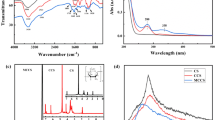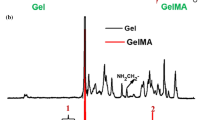Abstract
Metal-ligand coordination bonding is a non-covalent interaction that has been extensively studied as an effective way to improve the mechanical properties of hydrogels or to generate novel supramolecular self-healing gels. In this study, biodegradable polyaspartamide derivatives conjugated with histamine were synthesized and used to prepare the metal-coordinated supramolecular gel with several different metal-ions such as Cu(II), Ni(II), and Zn(II) in an aqueous solution. The resulting gels showed high adhesive properties on glass and plastics substrates, and the adhesive strength could be modulated by using different metal-ion species as well as the concentration and medium pH. In particular, the Cu(II)-coordinated gel exhibited a reversible self-healing behavior and good antibacterial activity. These wholly bio-based supramolecular polymer gels have potential for various biomedical applications with their multifunctional properties comprising adhesive, self-healing and antimicrobial properties in wet gel state.














Similar content being viewed by others
References
Peak CW, Wilker JJ, Schmidt G (2013) A review on tough and sticky hydrogels. Colloid Polym Sci 291:2031–2047
Jen AC, Wake CM, Mikos AG (1996) Hydrogels for cell immobilization. Biotechnol Bioeng 50:357–364
Hirst AR, Escuder B, Miravet JF, Smith DK (2008) High-tech applications of self-assembling supramolecular nanostructured gel-phase materials: from regenerative medicine to electronic devices. Angew Chem Int Ed 47:8002–8018
Seo JH, Lee JS, Kim JH (2015) Swelling characteristics and Pb(II) ion adsorption properties of superabsorbent gel based on dopamine-conjugated poly(aspartic acid). Polym-Korea 39:917–924
Cordier P, Tournilhac F, Soulie-Ziakovic C, Leibler L (2008) Self-healing and thermoreversible rubber from supramolecular assembly. Nature 451:977–980
Montarnal D, Cordier P, Soulié-Ziakovic C, Tournilhac F, Leibler L (2008) Synthesis of self-healing supramolecular rubbers from fatty acid derivatives, diethylene triamine, and urea. J Polym Sci Polym Chem 46:7925–7936
Bode S, Bose RK, Matthes S, Ehrhardt M, Seifert A, Schacher FH, Paulus RM, Stumpf S, Sandmann B, Vitz A, Winter A, Hoeppener S, Garcia SJ, Spange S, van der Zwaag S, Hager MD, Schubert US (2013) Self-healing metallopolymers based on cadmium bis(terpyridine) complex containing polymer networks. Polym Chem 4:4966–4973
Burattini S, Greenland BW, Merino DH, Weng W, Seppaia J, Colquhoun HM, Hayes W, Mackay ME, Hamley IW, Rowan SJ (2010) A healable supramolecular polymer blend based on aromatic π− π stacking and hydrogen-bonding interactions. J Am Chem Soc 132:12051–12058
Kakuta T, Takashima Y, Nakahata M, Otsubo M, Yamaguchi H, Harada A (2013) Preorganized hydrogel: self healing properties of supramolecular hydrogels formed by polymerization of host–guest monomers that contain cyclodextrins and hydrophobic guest groups. Adv Mater 25:2849–2853
Kalista SJ, Pflug JR, Varley RJ (2013) Effect of ionic content on ballistic self-healing in EMAA copolymers and ionomers. Polym Chem 4:4910–4926
Krogsgaard M, Behrens MA, Pedersen JS, Birkedal H (2013) Self-healing mussel-inspired multi-pH-responsive hydrogels. Biomacromolecules 14:297–301
Piepenbrock MOM, Clarke N, Steed JW (2009) Metal ion and anion-based “tuning” of a supramolecular metallogel. Langmuir 25:8451–8456
Li X, Zhang H, Zhang P, Yu Y (2018) A Sunlight-Degradable Autonomous Self-Healing Supramolecular Elastomer for Flexible Electronic Devices. Chem Mater 30:3752–3758
Wang Y, Huang F, Chen X, Wang XW, Zhang WB, Peng J, Li J, Zhai M (2018) Stretchable, Conductive, and Self-Healing Hydrogel with Super Metal Adhesion. Chem Mater 30:4289–4297
Tran NB, Moon JR, Jeon YS, Kim J, Kim JH (2017) Adhesive and self-healing soft gel based on metal-coordinated imidazole-containing polyaspartamide. Colloid Polym Sci 295:655–664
Scialabba C, Rocco F, Licciardi M, Pitarresi G, Ceruti M, Giammona G (2012) Amphiphilic polyaspartamide copolymer-based micelles for rivastigmine delivery to neuronal cells. Drug Deliv 19:307–316
Lin JJ, Lin WC, Li SD, Lin CY, Hsu SH (2013) Evaluation of the Antibacterial Activity and Biocompatibility for Silver Nanoparticles Immobilized on Nano Silicate Platelets. ACS Appl Mater Interface 5:433–443
Moon JR, Kim JH (2010) Biodegradable stimuli-responsive hydrogels based on amphiphilic polyaspartamides with tertiary amine pendent groups. Polym Int 59:630–636
Moon JR, Kim MW, Kim D, Jeong JH, Kim JH (2011) Synthesis and self-assembly behavior of novel polyaspartamide derivatives for anti-tumor drug delivery. Colloid Polym Sci 286:63–71
Moon JR, Jeon YS, Zrinyi M, Kim JH (2013) pH-Responsive PEGylated nanoparticles based on amphiphilic polyaspartamide: preparation, physicochemical characterization and in vitro evaluation. Polym Int 62:1218–1224
Huynh NT, Jeon YS, Kim D, Kim JH (2013) Preparation and swelling properties of “click” hydrogel from polyaspartamide derivatives using tri-arm PEG and PEG-co-poly(amino urethane) azides as crosslinking agents. Polymer 54:1341–1349
Giammona G, Pitarresi G, Cavallaro G, Carlisi B, Craparo EF, Mandracchia D (2006) pH-sensitive hydrogel based on a polyaspartamide derivative. J Drug Del Sci Tech 16:77–84
Pitarresi G, Pierro P, Palumbo FS, Tripodo G, Giammona G (2006) Photo-cross-linked hydrogels with polysaccharide−poly(amino acid) structure: new biomaterials for pharmaceutical applications. Biomacromolecules 7:1302–1310
Feldner T, Haring M, Saha S, Esquena J, Banerjee R, Diaz DD (2016) Supramolecular metallogel that imparts self-healing properties to other gel networks. Chem Mater 28:3210–3217
Rivas BL, Maturana HA, Molina MH, Gomez-Anton MR, Pierola IF (1998) Metal ion binding properties of poly(N-vinylimidazole) hydrogels. J Appl Polym Sci 67:1109–1118
Pekel N, Guven O (1999) Investigation of complex formation between poly(N-vinyl imidazole) and various metal ions using the molar ratio method. Colloid Polym Sci 277:570–573
Pestov AV, Privar YO, Ustinov AY, Voit AV, Azarova YA, Mekhaev AV, Bratskaya SY (2016) Effect of polymer backbone chemical structure on metal ions binding by imidazolylmethyl derivatives. Chem Eng J 283:323–329
Yi X, He J, Wang X, Zhang Y, Tan G, Zhou Z, Chen J, Chen D, Wang R, Tian W, Yu P, Zhou L, Ning C (2018) Tunable mechanical, antibacterial, and cytocompatible hydrogels based on a functionalized dual network of metal coordination bonds and covalent crosslinking. ACS Appl Mater Interface 10:6190–6198
Lazaro-Martinez JM, Monti GA, Chattaj AK (2013) Insight into the coordination sphere of copper ion in polymers containing carboxylic acid and azole groups. Polymer 54:5214–5221
Trojer MA, Movahedi A, Blanck H, Nyden M (2013) Imidazole and triazole coordination chemistry for antifouling coating. J Chem 2018: ID 946739:23
Kara A, Uzun L, Besirli N, Denizli A (2017) Poly(ethylene glycol dimethacrylate-n-vinyl imidazole) beads for heavy metal removal. J Hazard Mater 106:93–99
Klingkajon W, Supaphol P (2014) Novel copper (II) alginate hydrogels and their potential for use as anti-bacterial wound dressings. Biomed Mater 99: 045008:11
Ingle AP, Duran N, Rai M (2014) Bioactivity, mechanism of action, and cytotoxicity of copper-based nanoparticles: A review. Appl Microbiol biotechnol 98:1001–1009
Villanueva ME, Diez AMR, Gonzalez JA, Perez CJ, Orrego M, Piehl L, Teves S, Copello GJ (2016) Antimicrobial activity of starch hydrogel incorporated with copper nanoparticles. ACS Appl Mater Interfaces 8:16280–16288
Nakato T, Kusuno A, Kakuchi T (2000) Synthesis of poly(succinimide) by bulk polycondensation of L-aspartic acid with an acid catalyst. Polym Chem 38:117–122
Tomida M, Nakato T, Kuramochi M (1996) Novel method of synthesizing poly(succinimide) and its copolymeric derivatives by acid-catalysed polycondensation of L-aspartic acid. Polymer 37:4435–4437
Vlasak J, Rypacek F, Drobnik J, Saudek V (1979) Properties and reactivity of polysuccinimide. J Polym Sci 66:59–64
Tran NB, Kim JY, Kim YC, Kim YJ, Kim JH (2015) CO2-responsive swelling behavior and metal-ion adsorption properties in novel histamine-conjugated polyaspartamide hydrogel. J Appl Polym Sci 133:43305
Tella AC, Obaleye JA (2010) Metal complexes as antibacterial agents: Synthesis, characterization and antibacterial activity of some 3d metal complexes of sulphadimidine. Orbital Elec J Chem 2:11–26
Appleton TG, Pesch FJ, Wienken M, Menzer S, Lippert B (1992) Linkage isomerism in square-planar complexes of platinum and palladium with histidine and derivatives. Inorg Chem 31:4410–4419
Tsiveriotis P, Hadjiliadis N (1999) Studies on the interaction of histidyl containing peptides with palladium(II) and platinum(II) complex ions. Coord Chem Rev 190–192:171–184
Fu G, Vary PS, Lin CT (2005) Anatase TiO2 nanocomposites for antimicrobial coatings. J Phys Chem B 12:8889–8898
Acknowledgements
This work was supported by the Basic Science Research Program through the National Research Foundation (NRF) of Korea, funded by the Ministry of Education, Science and Technology (NRF-2016R1D1A1A09918727).
Author information
Authors and Affiliations
Corresponding author
Rights and permissions
About this article
Cite this article
Moon, J.R., Jeon, Y.S., Kim, Y.J. et al. Adhesive, self-healing and antibacterial properties of Cu-coordinated soft gel based on histamine-conjugated polyaspartamide. J Polym Res 26, 12 (2019). https://doi.org/10.1007/s10965-018-1671-7
Received:
Accepted:
Published:
DOI: https://doi.org/10.1007/s10965-018-1671-7




